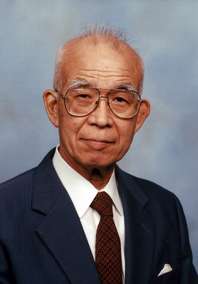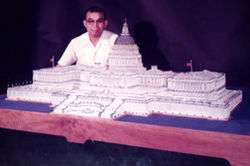Mitsugi Ohno
Mitsugi Ohno (大野 貢, Ōno Mitsugi, June 28, 1926 – October 22, 1999) was a Japanese glassblower who worked at the University of Tokyo (1947–1960) and Kansas State University (1961–1996). He was known for blowing a glass Klein bottle and glass models of historic buildings and ships. He told people "Anything that can be made with glass I can make it."
Mitsugi Ohno | |
|---|---|
 Ohno in 1999 | |
| Born | June 28, 1926 Bato, Tochigi Prefecture, Japan |
| Died | October 22, 1999 Manhattan, KS, U.S.A. |
| Occupation | Glassblower |
Early life
Mitsugi Ohno was born June 28, 1926 in Bato-machi, Tochigi-ken, Japan. His parents were Shigeo Ohno and Tsuya Ohgane Ohno, heads of the family rice farm in Bato-machi. He was the third son of seven children (Tsukasa, Hitoshi, Mitsugi, Kazuko, Rinko, Midori, and Mutsuko). He graduated from Kitamukata Elementary School in 1939. Because of his rebellious nature, after graduating from 6th grade, his parents sent him to be an apprentice with his uncle, who owned the Takagi Scientific Glass Instrument Company in Tokyo.
Glassblowing in Japan
Ohno served as an apprentice from 1939 to 1945. During the war, he also worked as a glassblower in the research department of the Naval Medical Supply Division, reporting to Lieutenant Commander Yanagida. His apprenticeship ended on March 10, 1945 when the factory was burned down and his uncle was killed during the Bombing of Tokyo in World War II. At the age of 19, he returned to the family farm after World War II for two years.
In 1946, Professor Yanagida, who had returned to the Department of Chemistry University of Tokyo, invited him to work as the departmental glassblower, a position he held from 1947 to 1960. He became close friends with graduate students, who told him that his temperament was more suited to America. He emigrated to the US on February 5, 1961 at the age of 35 with his wife Kimiyo (29), son Tsutomu (5), and daughter Hiroko (5 months). His second daughter, Julie, was born in Manhattan, Kansas in 1971.
Glassblowing in Kansas
Professor Alvin B. Cardwell at Kansas State University offered him a position as a scientific glassblower for the University and he made scientific glassware used by physics and chemistry researchers at the university from 1961 until he retired from the position in 1996.
Klein bottle

In 1961, Professor Cardwell asked Mitsugi Ohno to construct a true glass Klein bottle, a one-sided figure formally described as “an enclosure continuous with its outer surface constructed by twisting a tube through an opening in the side of the tube and joining it to the other end". Klein bottles had previously been made by other glassblowers, but their versions were sealed and did not have an open hole where the tube went through the side of the bottle. After several days of failing to make such a Klein bottle with an opening, he declared it impossible. However, the solution to the problem was revealed in a dream and he rushed to his office to make it. It was the most difficult glass piece that he made in his long career, and the accomplishment of which he was most proud. His first successful version of a Klein bottle is on permanent display at Kansas State University's Student Union.
Historic ships and buildings
Ohno became known for producing glass scale-sculptures of historic buildings and ships, which he donated to local, national and international institutions.
His first piece of work was a model of the USS Constitution, presented to First Lady Mamie Eisenhower at the Eisenhower Presidential Center in 1972. His biggest project was the glass model of the United States Capitol, created for Bicentennial celebrations and still prominently displayed at the Smithsonian Institution. He completed 24 glass sculptures.
One of his lifetime highlights was a meeting with Emperor Akihito and Empress Michiko of Japan in 1992, which was attended by President and Mrs. Jon Wefald of Kansas State University, and Ohno's lifelong friend Professor Clifton Meloan and his wife. The University presented the Emperor and Empress with a glass model of the Himeji Castle, which now resides in the Imperial Palace in Tokyo.
Selected historic glass models
| Year | Title | Current residence ofmodel |
|---|---|---|
| 1972 | USS Constitution | Eisenhower Presidential Museum |
| 1972 | U.S. Independence Hall | The National Archives |
| 1973 | Alvin B. Cardwell Hall, KSU | Kansas State University |
| 1975 | John McCain Hall, KSU | Kansas State University |
| 1976 | U.S. Capitol Building | Smithsonian National Museum of American History |
| 1977 | Anderson Hall, KSU | Kansas State University |
| 1980 | White House | Reagan Presidential Museum |
| 1984 | Chemistry Hall, University of Tokyo | University of Tokyo |
| 1987 | A ceremonial carriage and harp | Imperial Palace, Tokyo, Japan |
| 1988 | Nikkō Tōshō-gū | Tochigi Prefectural Public Hall, Utsunomiya, Tochigi-ken, Japan |
| 1991 | Three festival floats | Bato-cho Province Historical Hall, Bato-cho, Tochigi-ken, Japan |
| 1992 | Himeji Castle | Hyogo Historical Museum, Himeji-shi, Hyōgo-ken, Japan |
| 1992 | The sailing vessel Mayflower | Kansas State University |
| 1992 | Columbus' Three Ships: Niña, Pinta, and Santa María | Kansas State University |
| 1992 | USS Nimitz | Kansas State University |
| 1994 | The sailing vessel Nihon-maru | The Imperial Palace, Tokyo, Japan |
| 1995 | USS Missouri | Kansas State University |
| 1996 | USS Constitution | Kansas State University |
| 1997 | The sailing vessel Kanrin-maru | Japanese Consulate General, Kansas City |
| 1998 | HMS Victoria | Kansas State University |
| 1998 | Two-story home of Dwight Eisenhower | Dwight D. Eisenhower Presidential Museum |
End of career
Mitsugi Ohno was diagnosed with gastric cancer in January, 1999. He ended his 60-year glassblowing career on October 4, 1999, with a two-hour work session on the unfinished Japanese ship Kanrin-maru. Ohno died peacefully in his sleep on October 22, 1999. The unfinished ship and the tools he used during his career are on display in the Department of Chemistry, Kansas State University. His widow, Nao Ohno, three children and four grandchildren survive.
Selected references
- A Japanese in Kansas: A Man Captivated by Glass. Mitsugi Ohno. Published in Japan by Kodansha: Tokyo, Japan 1990. ISBN 4-06-204233-9
- Tokens and Treasures: Gifts to Twelve Presidents. Lisa B. Auel, Editor. National Archives and Records Administration and the White House Historical Association, 1996. ISBN 1-880875-10-1